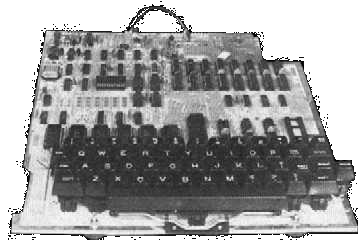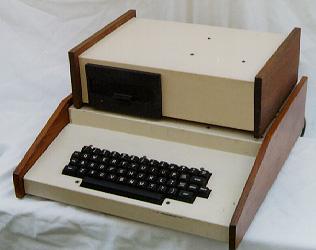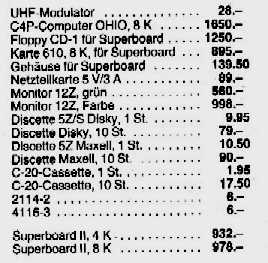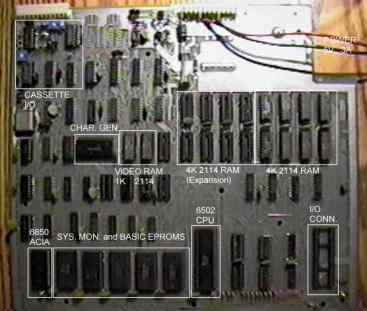
![]() How all began
How all began

Superboard II single board view
![]() TI-
TI-
After my TI-
The board was a revision B and had from the previous owner some enhancements in the VDU section to display the entire 32x32 characters on a standard TV monitor.
The main board design was quite simple by today's standards but the double sided board had a good quality ideal to do various modifications. The chips were 'normal' TTL and the board contained the keyboard, CPU, ROM, RAM (up to 8K on board), a video section for connection to a monitor or TV via an RF modulator, and cassette I/O.
Upon boot-
![]() Machine view
Machine view

Not my case but very close
The software was supplied on cassette tapes which loaded at 300 baud, with some enhancements up to 600 baud.
Later the "naked" board became a nice self made wodden case. I have seen, that such a case was typical for many Superboard or Compukit user to compete with Apple or Atari machines.
![]() Superboard distribution
Superboard distribution

Marked price in DM of a German distrubutor in 1982
Machine details found on http://its.svensson.org about the OSI C2-
![]() Board hardware/software details
Board hardware/software details

Main board layout
General: The C2-
to the SOL-
is discontinued, but is still available on retail. The C2-
17"x15"x10". It resembles pictures of the SWTP 6800 system.
All jacks are on the back panel and the front panel has a
shiny silver panel on a blue background. It has a MONSTER of
a power supply. The C4 and C8 are OSI's new versions of the
C2-
plug in a CRT and +5 volts and you're up. The C1P is the SBII
with a case and power supply.
Prices: C2-
plus $1000 for 8" floppies. C4 is $700, $1700 with
mini floppies, and the C8 is $900, $2600 with 8" floppies (2).
The SBII is $280, C1P is $400, $1000 with 20K RAM and 5.25"
disk drive.
Bus: The OSI C2, C4 & C8 all use OSI's 48 pin bus. This is an
extremely noise free bus, but has drawbacks that should be
noted. It is not S100 and in the C2-
a 4 slot backplane, and two slots are used in the basic
configuration. The C2-
numerous boards for the 48 pin bus, notable are the Votrax (R)
unit, the universal telephone interface <phone-
ultimate!>, AC remote control, home security system, and many
static & dynamic memory boards.
CPU:
The C1, C2s, C4 & C8 are controlled by a 6502 micro-
Therefore, they cannot run CP/M 8080, Z80, or 6800 code; but this is no
drawback for there are millions of programs written in 6502 code.
Ports: Three RCA phono jacks on the rear panel take care of the video
out <yes, RCA jack, Virginia>, tape in, tape out. I have
changed these jacks on my computer to BNC, and phone,
respectively. For the video interface, simply connect the RCA
jack to the input of any CRT monitor. If you prefer to avoid
that expense, use any low cost RF modulator to hook it up to
your TV set's antenna terminals. The floppies for the C4 and
C8 have extended ports (e.g. RTC, home security, DA/AD
converters and much more.)
Display: C1 and SBII have a 24x24 screen. The C2, C4 and C8 have a
64x27 screen, (software selectable 32x27). The C4 and C8 have
color graphics (the others are Black&White).
Keyboard: The C2-
operate. It is a real typewriter style keyboard with
capacitive contacts and the "feel" to a touch typist is almost
indistinguishable from an office typewriter. The C2-
detached keyboard.
Mass Storage: The C2-
the C2-
mini-
upgrades for the C2-
one needs to do is order whichever upgrade he wants, and
simply plug it in himself. The 630 board is available for
adding disk(s) to the SBII. The C1P is available with 5.25" floppies.
Operating System:
All the computers support Microsoft 8k basic <made
by the same people that designed Applesoft, RS L2, PET, and I
believe Atari basics> in ROM. There is also a system
mini-
stands for "disk boot"; C stands for "Coldstart ROM Basic"; W
for warmstart <either disk or ROM basic>; and M is for
monitor.
Software: OSI has a large line of educational, business, personal and
game programs, and Aardvark Electronics has a large catalog
devoted to OSI hard/software; also Kilobaud magazine has
started publishing many OSI articles lately. OSI's public
relations have improved greatly too. Problems in finding
support for OSI computers is definitely a thing of the past.